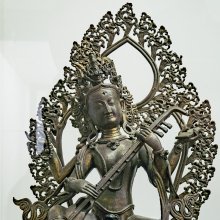Lute, Lūte, Luṭe: 4 definitions
Introduction:
Lute means something in Hinduism, Sanskrit, biology. If you want to know the exact meaning, history, etymology or English translation of this term then check out the descriptions on this page. Add your comment or reference to a book if you want to contribute to this summary article.
Images (photo gallery)
In Hinduism
Natyashastra (theatrics and dramaturgy)
Source: Shodhganga: Elements of Art and Architecture in the Trtiyakhanda of the Visnudharmottarapurana (natya)The Lute is associated with Mṛgaśīrṣa-hasta: one of the twenty-two Single-hand Gestures (in Indian Dramas) (known as asaṃyuktahastas), according to the Viṣṇudharmottarapurāṇa, an ancient Sanskrit text which (being encyclopedic in nature) deals with a variety of cultural topics such as arts, architecture, music, grammar and astronomy.—The word mṛgaśīrṣa is the union of two words viz., mṛga and śīrṣa. The word mṛga means deer and śīrṣa means head. So, it can be said that the hand posture which is called mṛgaśīrṣa identifies a posture that looks like the head of a deer. [...] In the Abhinayadarpaṇa, the mṛgaśīrṣa-hasta posture is used to denote various things. This book states that this posture is used to show woman, cheek, wheel, limit, terror, quarrel, attire and to call someone or the beloved, the lute, foot massage, female organ, holding umbrella etc.

Natyashastra (नाट्यशास्त्र, nāṭyaśāstra) refers to both the ancient Indian tradition (shastra) of performing arts, (natya—theatrics, drama, dance, music), as well as the name of a Sanskrit work dealing with these subjects. It also teaches the rules for composing Dramatic plays (nataka), construction and performance of Theater, and Poetic works (kavya).
Biology (plants and animals)
Source: Wisdom Library: Local Names of Plants and DrugsLute [लुते] in the Nepali language is the name of a plant identified with Nepeta leucophylla from the Lamiaceae (Mint) family. For the possible medicinal usage of lute, you can check this page for potential sources and references, although be aware that any some or none of the side-effects may not be mentioned here, wether they be harmful or beneficial to health.

This sections includes definitions from the five kingdoms of living things: Animals, Plants, Fungi, Protists and Monera. It will include both the official binomial nomenclature (scientific names usually in Latin) as well as regional spellings and variants.
Languages of India and abroad
Kannada-English dictionary
Source: Alar: Kannada-English corpusLūte (ಲೂತೆ):—
1) [noun] a spider.
2) [noun] an ant.
3) [noun] a kind of cutaneous disease (said to be produced by the moisture from a spider).
Kannada is a Dravidian language (as opposed to the Indo-European language family) mainly spoken in the southwestern region of India.
Nepali dictionary
Source: unoes: Nepali-English Dictionary1) Luṭe (लुटे):—adj. 1. (of plants) lacking growth; dwarfish; 2. (of man or beasts) short-eared;
2) Lute (लुते):—adj. 1. suffering from scabies; 2. weak; thin; feeble;
Nepali is the primary language of the Nepalese people counting almost 20 million native speakers. The country of Nepal is situated in the Himalaya mountain range to the north of India.
See also (Relevant definitions)
Starts with: Lutengra, Lutengro, Lutera, Lutero, Lutete.
Query error!
Full-text (+494): Vina, Vallaki, Kandolavina, Prakvana, Mahati, Kakubha, Kelikala, Balancita, Tantri, Vinin, Sutravina, Candalavallaki, Praseva, Candalika, Vipanci, Parivada, Vinavada, Dhvaninala, Vipancika, Vyanjanadhatu.
Relevant text
Search found 168 books and stories containing Lute, Lūte, Luṭe, The lute; (plurals include: Lutes, Lūtes, Luṭes, The lutes). You can also click to the full overview containing English textual excerpts. Below are direct links for the most relevant articles:
Manasara (English translation) (by Prasanna Kumar Acharya)
Chapter 58 - The images of Yakṣas, Vidyādharas, and other mythical beings
Chapter 43 - The cars and chariots (ratha-lakṣaṇa)
Part 5 - General survey (summary of contents) < [Preface]
Trishashti Shalaka Purusha Caritra (by Helen M. Johnson)
Part 9: Marriage with Gandharvaṣenā, daughter of Cārudatta < [Chapter II - Marriages of Vasudeva with maidens]
Part 22: Bharata resumes normal life < [Chapter VI]
Part 8: Later history of the image < [Chapter XI - The story of Rauhiṇeya]
Tattvasangraha [with commentary] (by Ganganatha Jha)
Verse 3080-3082 < [Chapter 25 - Examination of the Doctrine of ‘Self-sufficient Validity’]
Verse 3083 < [Chapter 25 - Examination of the Doctrine of ‘Self-sufficient Validity’]
Amarakoshodghatana of Kshirasvamin (study) (by A. Yamuna Devi)
Musical instruments (e.g., Stringed, Percussions, Cymbals and Wind-blown) < [Chapter 4 - Cultural Aspects]
Music (Nāṭya-varga) < [Chapter 4 - Cultural Aspects]
Education (5): Linguistic principles < [Chapter 4 - Cultural Aspects]
Village Folk-tales of Ceylon (Sri Lanka), vol. 1-3 (by Henry Parker)
Story 128 - The Magic Lute Player < [Part III - Stories of the Cultivating Caste]
Story 151 - Concerning A Royal Princess And A Turtle < [Part III - Stories of the Cultivating Caste]
Story 100 - The Story Of The Pearl Necklace < [Part III - Stories of the Cultivating Caste]
Yavanajataka by Sphujidhvaja [Sanskrit/English] (by Michael D Neely)
Verse 1.20 < [Chapter 1 - The Innate Nature of the Zodiac Signs and Planets]
Verse 1.16 < [Chapter 1 - The Innate Nature of the Zodiac Signs and Planets]
Verse 2.10 < [Chapter 2 - One’s Own Form of the Horās]
